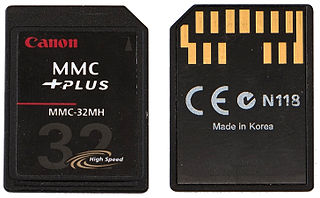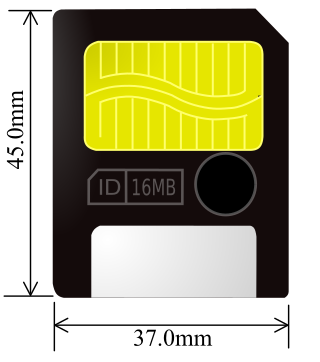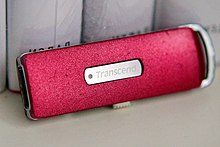
Flash memory is an electronic non-volatile computer memory storage medium that can be electrically erased and reprogrammed. The two main types of flash memory, NOR flash and NAND flash, are named for the NOR and NAND logic gates. Both use the same cell design, consisting of floating gate MOSFETs. They differ at the circuit level depending on whether the state of the bit line or word lines is pulled high or low: in NAND flash, the relationship between the bit line and the word lines resembles a NAND gate; in NOR flash, it resembles a NOR gate.

A memory card is an electronic data storage device used for storing digital information, typically using flash memory. These are commonly used in digital portable electronic devices, such as Digital cameras as well as in many early games consoles such as the Nintendo Wii. They allow adding memory to such devices using a card in a socket instead of protruding USB flash drives.

CompactFlash (CF) is a flash memory mass storage device used mainly in portable electronic devices. The format was specified and the devices were first manufactured by SanDisk in 1994.
Wear leveling is a technique for prolonging the service life of some kinds of erasable computer storage media, such as flash memory, which is used in solid-state drives (SSDs) and USB flash drives, and phase-change memory. There are several wear leveling mechanisms that provide varying levels of longevity enhancement in such memory systems.
In computing, a removable media is a data storage media that is designed to be readily inserted and removed from a system. Most early removable media, such as floppy disks and optical discs, require a dedicated read/write device to be installed in the computer, while others, such as USB flash drives, are plug-and-play with all the hardware required to read them built into the device, so only need a driver software to be installed in order to communicate with the device. Some removable media readers/drives are integrated into the computer case, while others are standalone devices that need to be additionally installed or connected.

MultiMediaCard, officially abbreviated as MMC, is a memory card standard used for solid-state storage. Unveiled in 1997 by SanDisk and Siemens, MMC is based on a surface-contact low pin-count serial interface using a single memory stack substrate assembly, and is therefore much smaller than earlier systems based on high pin-count parallel interfaces using traditional surface-mount assembly such as CompactFlash. Both products were initially introduced using SanDisk NOR-based flash technology.

A flash drive is a data storage device that includes flash memory with an integrated USB interface. A typical USB drive is removable, rewritable, and smaller than an optical disc, and usually weighs less than 30 g (1 oz). Since first offered for sale in late 2000, the storage capacities of USB drives range from 8 to 256 gigabytes (GB), 512 GB and 1 terabyte (TB). As of 2023, 2 TB flash drives were the largest currently in production. Some allow up to 100,000 write/erase cycles, depending on the exact type of memory chip used, and are thought to physically last between 10 and 100 years under normal circumstances.

SmartMedia is an obsolete flash memory card standard owned by Toshiba, with capacities ranging from 2 MB to 128 MB. The format mostly saw application in the early 2000s in digital cameras and audio production. SmartMedia memory cards are no longer manufactured.

The xD-Picture Card is an obsolete form of flash memory card, used in digital cameras made by Olympus, Fujifilm, and Kodak during the 2000s. The xD in the xD-Picture Card stands for eXtreme Digital.

Transcend Information, Inc. is a Taiwanese company headquartered in Taipei, Taiwan that manufactures and distributes memory products. Transcend deals in over 2,000 products including memory modules, flash memory cards, USB flash drives, portable hard drives, multimedia products, solid-state drives, dashcams, body cameras, personal cloud storage, card readers and accessories.

Lexar International is a brand of flash memory products manufactured by the Chinese memory company Longsys.
This table provides summary of comparison of various flash memory cards, as of 2017.

A memory card reader is a device for accessing the data on a memory card such as a CompactFlash (CF), Secure Digital (SD) or MultiMediaCard (MMC). Most card readers also offer write capability, and together with the card, this can function as a pen drive.

A solid-state drive (SSD) is a solid-state storage device. It provides persistent data storage using no moving parts. It is sometimes called semiconductor storage device or solid-state device; it is also called solid-state disk because it is frequently interfaced to a host system in the same manner as a hard disk drive.

Phison Electronics Corporation is a Taiwanese public electronics company that primarily designs, manufactures and sells controllers for NAND flash memory chips. These are integrated into flash-based products such as USB flash drives, memory cards, and solid-state drives (SSDs).

In electronics, a multi-level cell (MLC) is a memory cell capable of storing more than a single bit of information, compared to a single-level cell (SLC), which can store only one bit per memory cell. A memory cell typically consists of a single floating-gate MOSFET, thus multi-level cells reduce the number of MOSFETs required to store the same amount of data as single-level cells.

Computer hardware comprises the physical parts of a computer, such as the central processing unit (CPU), random access memory (RAM), motherboard, computer data storage, graphics card, sound card, and computer case. It includes external devices such as a monitor, mouse, keyboard, and speakers.

A flash memory controller manages data stored on flash memory and communicates with a computer or electronic device. Flash memory controllers can be designed for operating in low duty-cycle environments like memory cards, or other similar media for use in PDAs, mobile phones, etc. USB flash drives use flash memory controllers designed to communicate with personal computers through the USB port at a low duty-cycle. Flash controllers can also be designed for higher duty-cycle environments like solid-state drives (SSD) used as data storage for laptop computer systems up to mission-critical enterprise storage arrays.

The XQD card is a memory card format primarily developed for flash memory cards. It uses PCI Express as a data transfer interface.

CFexpress is a standard for removable media cards proposed by the CompactFlash Association (CFA). The standard uses the NVM Express protocol over a PCIe 3.0 interface with 1 to 4 lanes where 1 GB/s data can be provided per lane. There are multiple form factors that feature different PCIe lane counts. One of the goals is to unify the ecosystem of removable storage by being compatible with standards already widely adopted, such as PCIe and NVMe. There already is a wide range of controllers, software and devices that uses these standards, accelerating adoption.

















